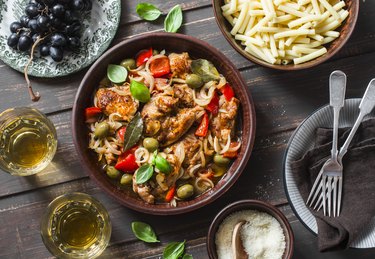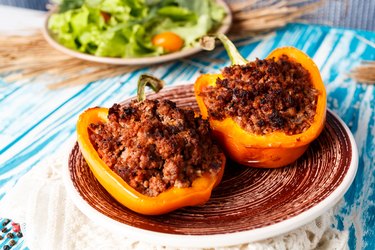A popular way to cook turkey giblets is to boil them, which prepares them for use in gravy or just to eat plain. These pieces of meat need to be cooked properly to keep you safe from foodborne illnesses.
You can boil turkey giblets and then use them in a stew or add them to gravy to spread over turkey meat.
Turkey giblets – the neck, heart, gizzard and liver of the bird – are packed with incredible flavor. When simmered, these unappreciated pieces impart rich, concentrated turkey essence that can elevate holiday gravies, soups and stuffings. But to unlock their full potential, you need to know the proper boil time. Undercook the giblets and you risk foodborne illness and tough, chewy textures. Boil them too long and the broth turns cloudy while the organs take on an overly strong taste. So how long should you boil turkey giblets to get perfect results?
What Are Turkey Giblets?
Let’s start with an overview of what exactly turkey giblets are. The giblets are the edible inner parts of a whole raw turkey, typically found wrapped in a bag inside the body cavity. A standard giblet package contains:
-
Turkey Liver – The largest organ which has a smooth texture when cooked.
-
Turkey Heart – Shaped like a triangle and mimics the texture of muscle meat when cooked.
-
Turkey Gizzard – Part of the digestive system that grinds up food, so it’s very tough and chewy.
The neck is often included with the giblets. Composed of bone, cartilage and meat, the long skinny neck makes giblet broth more gelatinous.
Why Bother Cooking Turkey Giblets?
You may wonder why go through the hassle of boiling and eating these unglamorous turkey bits. Here are some great reasons to use giblets:
-
Rich, concentrated flavor – Long simmering draws out and concentrates the turkey essence, giving incredible savory depth.
-
Thickens gravy – The collagen in neck bones and connective tissue in giblets helps thicken and add body to gravy.
-
Nutrient density – Organ meats like giblets offer more vitamins and minerals than turkey breast meat.
When prepared properly, turkey giblets impart far more flavor than the work required to cook them. Let’s look at exactly how long you need to boil them.
How Long to Boil Turkey Giblets
To extract maximum flavor and make the giblets tender enough to eat, follow these approximate boil times:
-
Turkey Neck – Simmer for 45 minutes to 1 hour until very soft and meat easily pulls away from the bones.
-
Turkey Giblets – Place in simmering liquid and cook for 45 minutes up to 1 hour. The gizzard takes the longest to become tender.
-
Combination – Simmer neck and giblets together for 45 minutes to 1 hour until fully cooked through.
The range accounts for differences in altitude and the quantity/size of giblets. Always use a thermometer to confirm the internal temperature reaches 165°F.
Tips for Boiling Turkey Giblets
Follow these tips for best results when boiling giblets:
-
Simmer gently – boiling causes tough, chewy giblets.
-
Use a mix of water and broth – balances flavor and prevents over-salinity.
-
Add aromatics – mirepoix veggies, herbs and spices boost flavor.
-
Skim foam and fat – for a clearer, cleaner tasting broth.
-
Use a small pot – prevents diluting the broth.
-
Strain well – remove all solids after cooking.
-
Chill and defat – if using broth for gravy, chill and remove fat before using.
What to Do with Cooked Turkey Giblets
Once simmered, don’t let those flavorful cooked giblets go to waste! Here are some delicious ways to use them:
-
Finely chop and mix into gravy.
-
Dice and add to stuffing for moisture and richness.
-
Puree into giblet pâté to spread on crackers.
-
Dice and add to soups like turkey noodle or turkey rice soup.
-
Mix chopped giblets into dirty rice or turkey pilaf.
With the proper 45 minute to 1 hour gentle simmer, you can transform turkey giblets into incredible flavor enhancers for your Thanksgiving recipes. Just be sure not to overcook them, which results in a strong liver taste and cloudy broth. Master the simple art of boiling giblets and you’ll never discard these flavorful gems again!
Frequently Asked Questions About Boiling Turkey Giblets
Still have questions about boiling turkey giblets? Here are answers to some frequently asked questions:
What temperature should I boil the giblets?
Bring the liquid to a gentle simmer between 180°F – 205°F. This slower cook time extracts more flavor than a rapid boil.
Do I need to rinse the giblets before boiling?
Yes, always rinse giblets under cold water before cooking to remove any blood or debris. Pat them dry with paper towels.
Should I boil the turkey liver separately?
No need. You can simmer the liver right along with the heart, gizzard and neck. They will all become tender in 45 minutes to 1 hour.
Can I freeze cooked giblets?
Absolutely. Allow giblets to fully cool before freezing in an airtight container up to 4 months. Thaw overnight in the fridge before using.
Is the broth from boiled giblets safe to consume?
Yes, provided you simmered them for the full cooking time. Strain and skim fat from the broth before use in gravy or soup.
With this handy guide, you now have all the info needed to properly boil turkey giblets. Remember to gently simmer between 45 minutes and 1 hour for tender, flavorful giblets that will boost the taste of your Thanksgiving recipes.
Turkey giblets: 25
Turkey neck: 7
Turkey liver: 4
Turkey heart: 3
Turkey gizzard: 5
Gentle simmer: 4
45 minutes to 1 hour: 6
Gravy: 5
Broth: 9

What Are Turkey Giblets?
The giblets of the turkey are actually three different organs: the liver, heart and gizzard. The gizzard is essentially the stomach of the turkey. While it might not sound appetizing, turkey giblets are great in recipes after theyve been boiled. Plus, organ meats provide high amounts of vitamin A and B vitamins.
Video of the Day
Hearts are made of muscle tissue and are rich in blood. Blood carries nutrients through the body, which is why heart tissue is more nutritious compared to meat. The liver creates bile, which doesnt sound appealing, but its loaded with vitamins and minerals.



The gizzard is particularly high in protein. As reported by the the USDA, 4 ounces contain 21 grams of protein and no carbs. By comparison, the same amount of raw giblets has 20.5 grams of protein, 140 calories and almost 6 grams of fat.
By eating just 4 ounces of turkey giblets, you can meet the recommended daily values (DV) for some vitamins. According the Food and Drug Administration (FDA), these dietary recommendations apply to adults and children over the age of four. Individual recommendations, however, may vary.
As the FDA notes, you should aim for about 6 micrograms of vitamin B12 daily. A 4-ounce serving of turkey giblets provides over 14 micrograms. While the FDA recommends 5,000 International Units (IU) of vitamin A per day, giblets contain almost 15,000 IU.



Turkey giblets wont satisfy the daily value for some nutrients, but they still provide a significant amount. Riboflavin is one example. The recommended daily value is 1.7 milligrams, and giblets contain 1.57 milligrams per serving.
Getting enough B-complex vitamins in your diet is important. According to a November 2016 study published in Maturitas, low levels of these nutrients are common in people with cognitive decline.
How to Properly Cook Giblets
You can purchase giblets at the store or from a butcher. Cooking them properly is essential because poultry products can be contaminated with salmonella. Eating under-cooked giblets can make you sick and even send you to the hospital.
The Centers for Disease Control and Prevention estimates that about 1.2 million people are infected with salmonella each year. This pathogen is responsible for 23,000 hospitalizations and 450 deaths in the United States annually.
To properly cook the giblets, put them in boiling water. Use a thermometer to measure their internal temperature, which should reach at least 165 degrees Fahrenheit, according to the U.S. Department of Health & Human Services. The texture of the giblets should change while they cook. After boiling, they should be crumbly, soft and easy to cut through.
